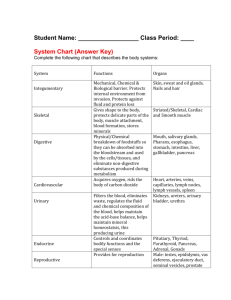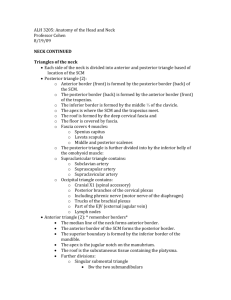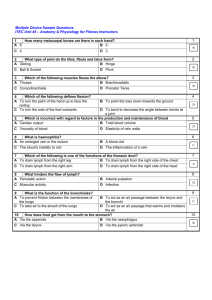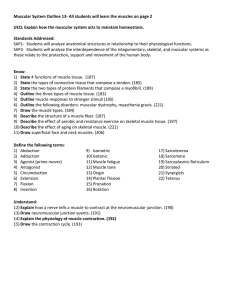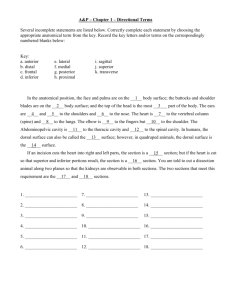ENT_examination
advertisement
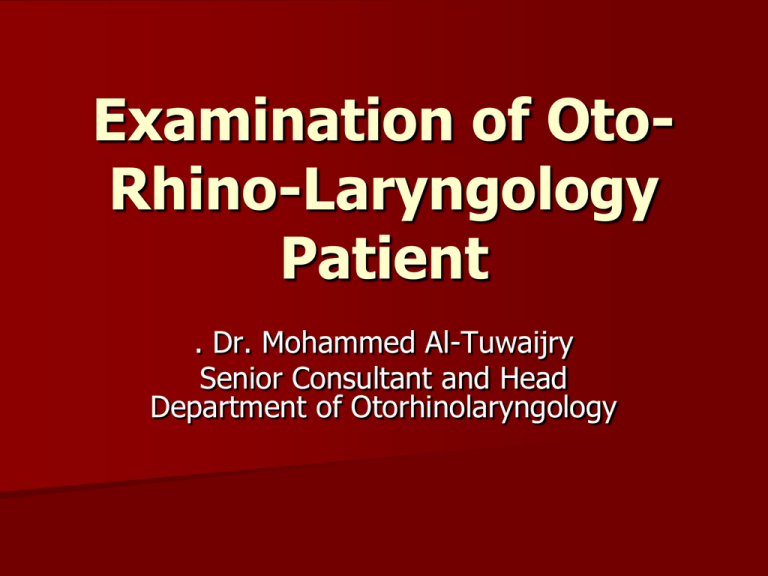
Examination of OtoRhino-Laryngology Patient . Dr. Mohammed Al-Tuwaijry Senior Consultant and Head Department of Otorhinolaryngology Otorhinolaryngology / HNS – What is it? 5- 6 years residency “Otto” – Ears “Rhiino” – Nose (+siinuses) “Laryngollogy” – Throatt (Aiirway) Head & Neck Surgery –Skullll base,, Salliivary gllands,, Face,, Neck General scheme of patient examination Personal history Beside the general information gained from the personal history in general for ear- nose and throat patient, special point should be expressed:– At the beginning of the history – Face – Pallor - Anemia - Chronic toxemia - Sever hemorrhage Movement - Paralysis - Twitches Scars - Old trauma - Surgery Swellings and orbital fissure - Acute - abscess – trauma Chronic – desmoids lacrimal sac disease Frontal sinus mucoceal Swellings Orbital fissure - Symmetrical or not - Proptosis 1) Bilateral – thyroid, exophthalmus 2) Unilateral - Orbital tumor - Sinus diseases - Unilateral pulsating prptosis with echymosis = - epiphora Bilateral – allergic or infective conjunctivitis. unilateral – lacrimal drainage blockage covernus sinus disease. Eyes in the central of face. Look for deviations, swellings, or scars. Auricle left and right symmetrical normal in shape and projection. Nose the upper lip and apex up between the two eyes. Congenital deformity such as cleft, dermoids, heamangioma, sinuses and fistulas. Talking to the patient Normal voice of the patient Hoarseness of voice – laryngeal disease Breathy voice – chest disease Nasal tone – nasal disease or naso pharyngeal disease Aphonia – hysterical or after removal of larynx Articulation defect- pathology in lips, teeth, palate or tongue Hearing evaluation Normal hearing patient hears the normal conversation. Weak hearing:-patient hears loud conversation. Sever hearing loss: - patient can't hear very loud speech. In conductive hearing loss the patient voice is low, but in sensory neural hearing loss the patient voice is high. Memory and orientation:Normally the patient is oriented in time and place and can tell his disease story very clearly. Abnormal patient can't tell his disease story and if you ask him about recent events of his daily life he will not remember. Occupation Working in dust:- expect allergy, chronic rhinosinusitis, chest problems. Wood dust:- cancer maxilla. Fumes and chemicals:- allergy, asthma rhinosinusitis, laryngitis. Teachers and singers:- chronic laryngitis with possible nodules. Drivers: - baro truma (otitis media, sinusitis), vertigo, due to rapture of round window membrane, perforation of tympanic membrane. Mushroom pickers and birds farmers:- allergic rhinitis and asthma due to fungus. Green houses and nursery: - allergy and asthma due to chemicals and fertilizers. Special habits - Smoking: - chronic rhinosinusitis, pharyngitis, laryngitis, bronchitis and tumors. - Drinking alcohol:- chronic laryngitis, hyperacidity and tumors. Complaint (C/O):- Should be written down in patient words. Past history: Medical problems - High blood pressure: - headache, bleeding, dizziness, tinnitus. - Diabetes: - recurrent infections; necrotizing otitis externa, sensory neural hearing loss, neuropathy, mucous membrane fungal infection - Asthma: - with or without allergic rhinitis, chronic throat infections, breathy voice. - Renal disease: - sensory neural hearing loss. - Rheumatic disease: - TMJ arthralgia, pain and headache. - Hormonal imbalance: - thyroid exophthalmoses, hearing loss in hypothyroidism. - Liver failure: - bleeding from mouth and nose. Drug allergy or complications - Aspirin allergy. - Oto-toxic drugs & Vestibule-toxic drugs - Nasal blockage with beta blockers. - Nasal bleeding with anti- coagulants. Surgical problems:- previous surgery of the diseased organ or complications of surgery or anesthesia.in general Trauma:- Noise – hearing loss. - Chemical- chronic sinusitis, laryngitis, anosmia. - Accidental – organ loss or deformity Allergic syndrome:- allergy is a systemic disease, which may give the following clinical diseases, rhinitis, conjunctivitis, asthma, eczema, laryngitis. History of psychic problems. History of present illness Onset – course of the disease – other symptoms that may arise from the same organ. - What increase or relieve the symptoms? - History of same disease before. And what medications given and what was the results of investigations? General examinations Examine the pulse, temperature, blood pressure (standing and laying down in dizziness). Examine the cranial nerves and the nervous system. Examine the lymph nodes, liver and spleen when malignant tumor is suspected. Examine the chest and heart. Local examination Inspection. Palpation. Endoscopy. Microscopy. Nose examination Nose is a pyramidal structure projecting in the midline of the face at the middle third, with the base at the upper lip and the apex between the orbits (root of the nose). – External nose examination – inspect the skin for swellings, ulcers, deviations humb, scars and abnormal colouration. Palpate for tenderness on the bony nose floor of frontal sinus and maxillary sinuses. Internal nose lateral wall ostea Medial wall – Internal nose examination- rise the tip with your finger and look inside the nose to see the skin of vestibule and part of nasal mucosa, then with nasal speculum examine the left and right nasal cavities, look for: Colour of mucous membrane – Normal- smooth glistening reddish white. – Acute rhinitis- congested red smooth. – Chronic rhinitis- congested red non smooth. – Allergic rhinitis – bluish white/ Amount, color and consistency of secretions – – – – – – – Normal- minimal amount of clear mucous. Acute rhinitis – profuse amount. Chronic rhinitis- mucoperulent discharge. Allergic rhinitis- profuse clear mucous discharge with swelling. Clear water discharge – CSF. Bloody discharge tumor or grannuloma. Fresh blood epistaxis. Nasal septum deviation. Inferior and Middle turbinate. Floor of the nose. Inferior and middle meatus. Presence of abnormal growth Clinical aspects of nasal disease – Nasal obstruction. Nasal discharge Fetor Epistaxis Smell disturbance Facial pain Facial deformity Specific diagnostic methods a) Nasal endoscopy b) Biochemical and immunologic investigation of the secretions c) Cytology and bacteriology d) Allergic investigation e) Biopsy To complete examination of the nose, the naso pharynx should be examined with endoscopy through the nose or with mirror through the mouth. – X-Ray conventional for sinuses and nasal bones in case of trauma, but C.T. is much more diagnostic. Ear examination – Inspect the auricles for shape, – redness, swelling, – ulceration, tumors, – fistula, and – retroauricular skin. – Palpate the auricles for – tenderness and pre or – post auricular scar /swelling or – tenderness. Inspect external canal Pull the auricle upward backward in adult or backward downward in infants and young children to see the external canal, which is S shaped, by this movement you find out if there is tenderness or not. Tenderness means otitis extena . The length of external canal 25mm, the outer third is cartilaginous lined with hairy skin and cerumen glands, and the inner tow thirds is bony. Normally the skin is smooth with some soft cerumen, the bottom of the canal is closed by the tympanic membrane, which is oval, gryish white, glistening, mobile membrane. It is oblique and concave. It shows the handle of malleus hanging downwards backwards and cone of light in the antro inferior sector. Examination to be done at this stage with otoscope or microscope. TYMPAMIC MEMBRANE -NORMAL CHRONIC PERFERATION Chronic O.M. Traumatic perferation – . Tympanic membrane may be : Red congested…. Acute otitis media Atrophic retrscted with prominent handle of malleus in long standing negative pressure- Secretory or adhesive otitis media. Thick with calcification white in color …. Tymanosclerosis. Perforated – central ….. marginal e) Ear discharge Brown mass – wax Moist keratin debri – otitis externa Moist dirty mass- fungus. Mucoid or mucoperulent discharge- chronic or acute otitis media. Scanty offensive perulent discharges – cholesteatoma/ Clear fluid – C.S.F. Bleeding – trauma, tumor. Serosangious discharge- polyp, viral otitis media, and traumatic rapture of tympanic membrane. Special test – Tuning fork test Weber's test – place the fork 512Hz in the midline on the for head or upper central incisors. The patient may hear– Equal in both ears= normal. – Better in the diseased ear- conductive hearing loss. – Better in the normal ear- sensory neural hearing loss. Rinne's test – the fork is placed one inch opposite the external canal, tell the patient stop hearing, then the fork is moved to the mastoid bone behind the earR.N… positive- the air conduction is better than bone conduction= normal hearing or sensory hearing loss. R.N.. negative- the bone conduction is better than air conduction = conductive hearing loss. Audiometry Pure tone audiometry Tympanometry A.B.R. [ Auditory Brain Response ] – X-ray Covential x-ray mastoids C.T. brain and skull base with or without contrast M.R.I. Functional assessment of the Eustachian Tube. - Valsalva's test - Tympanometry – for both intact membrane or dry perforation. Examination of mouth and pharynx Oral cavity is bounded anteriorly by the lips, and posteriorly by the anterior faucial archs, inferiorly by the floor of the mouth, and superiorly by the hard and soft palates. It is divided into regions and areas for clinical examination: Mouth vestibule – stars from lips deeply outside the dental arches. The Stensen's duct of parotid open opposite the second upper molar teeth. Dental arches with buccal gums and lingual gums Mandible interfaces with skull base via the TMJ and is held in position by the muscles of mastication Divided into components with weakest sites being the third molar area, socket of the canine tooth, and the condyle. Fracture Frequency Oral cavity proper – – Tongue – the tip, the margins, the body, the base, the dorsum, and the ventral surface. The upper surface is covered by modified epithelium containing the filiform papillae and the taste buds. The V shaped terminal sulcus separates the body from the base of the tongue. The central point is the foramen cecum, the remnant of the thyroglossal duct. Floor of the mouth: - it is below the lower surface of the tongue, the anterior part shows the openings of Wharton's ducts of submandibular glands and Bartholin's ducts of sublingual glands on both sides of lingual frenulum. The epithelial lining of the oral cavity consists of nonkeratinzed stratified squamous epithelium with subepithelial collections of minor salivary glands Pharynx it is long muscular tube about 12cm in length, extends from base of the skull down to level of cervical spine No.6. it is lined with mucosa and it is divided into three parts:- Nasopharynx: - extends from the base of skull down to the level of palate. Anteriorly open in the nose, inferiorly open in the oropharynx, laterally the Eustachian tube open on ether side. The epithelial lining is respiratory ciliated and stratified squamous epithelium, with transitional epithelium area. Oropharynx: - extends from the level of soft palate down to the upper edge of the epiglottis. It is continuous with the oral cavity through the faucial isthmus. It has posterior wall in front second and third cervical vertebrae, the lateral wall containing the palatine tonsil with anterior and posterior faucial pillars. The epithelial lining consists of nonkeratinizing stratified squamous epithelium. Hypopharynx:- extends from the upper edge of the epiglottis superiorly to the lower edge of cricoid cartilage it opens anteriorly into the larynx and on each side of the larynx lie the funnel-shaped piriform sinuses inferiorly its continues with esophagus the epithelial lining consist of nonkeratinized stratified squamusepithelium . Clinical aspects of diseases of the mouth and pharynx: – – – – – – – – – – – – – Pain on eating, chewing or swallowing. Dysphagia. Pain the neck. Globus symptoms. Burning of the tongue. Blood in the sputum. Catarrh. Oral fetor. Disorder of salivary secretion. Disorders of taste. Respiratory obstruction. Disorders of speech. Swellings of the neck,floor of mouth and of the lymph nodes at the angle of jaw and below the mandible. Methods of investigation: Palpation: of lips, dental arches, floor of the mouth for swellings ,submandibular area, submental, TMJs Inspection: by using tongue depressor, mirror, flexible rigid endoscopy Look for: The color, symmetrical mobility of the lips, skin of the lips, mucosa of lips and mouth vestibule. The arrangement of the teeth, occlusion, dental caries, temporomandibular joint mobility. The shape and mobility of the tongue, the upper surface and inferior surface. Mucosa of mouth, cheeks are examined for sensation, ulceration, dryness, tumors. The condition of hard and soft palate; smooth mucosa, mobility of soft palate, swellings, ulcers. Examine the parotid duct in the cheek opposite the upper second molar tooth and the opening of submandibular gland in the floor of the mouth on either side of frinulum. Examine the palatine tonsils:- size, crypts, cysts, ulcers or tumor. Radiography: Lateral view of the skull:- nasopharynx. Panorama of jaws:- dental cyst. Lateral view of the neck and upper thoracic region:- for hypopharynx and cervical esophagus to show foreign bodies. Contrast medium:- to show pharyngeal pouch, stenoses and swallowing disorders. CT-SCAN for skull base larynx. Carotid angiography for the highly vascular tumors and incases of bleeding for possible embolization of external carotid branche, Microbiology: Culture for bacteriologic, Mycological and virology examination. Biopsy: From any swelling which is not acutely inflamed or suspected highly Vascular. LARYNX: Embryology: The larynx develops from a two-part anlage: the supraglottis develops from a buccopharyngeal bud, the glottis and subglottis from a tracheobronchial bud. This fact has clinical significance in the postnatal period. Anatomy: The laryngeal skeleton consists of the thyroid. Cricoid, and arytenoids cartilages, ehich are hyaline cartilage, the epiglottis, which is fibrous cartilage and the fibroelastic accessory cartilages of Santorini and Wrisburg, which have no function. The laryngeal cavity is divided for clinical purposes into: Supraglottis. Glottis. Subglottis. The vocal cords length is 0.7 cm. in the newborn, 1.6 to 2 cm. in women, 2 to 2.4 in men. Functions of the laryngeal musculature: Opening of the glottis, abduction of the vocal cordsPosterior cricoarytenoid muscle(posticus muscle) Closure of the glottis adduction of V.C-Lateral cricoarytenoid, transverse arytenoids, thyroarytenoid, lateral part. Tension of the vocal cords-Cricothyroid muscle, thyroarytenoid muscle, medial part ( vocalis). The nerve supply: 1) Superior laryngeal nerve: a) Sensory internal branch supplies sensation down to the glottis. b) External branch the motor supply to the external cricothyroid muscle. 2) The recurrent laryngeal nerves left and right gives motor supply to the internal laryngeal muscles and sensation to the laryngeal mucosa below the glottis. Lymph drainage: No lymphatic capillaries in the vocal cord. Supraglottic drain in the superior cervical lymph nodes. Subglottic dran in inferior cervical lymph nodes, prelaryngeal, pretracheal nodes. Functions of the larynx: Phonation. Respiration. Protection of the lower airway: – – – – Closure of the aditus. Closure of the glottis. Reflex respiratory arrest. Cough reflex. Fixation of the thorax aided by glottic closure. Symptoms of laryngeal disease – Hoarseness – Stridor:- inspiratory type. – Irritative cough – Dysphagia Pain in the neck, which may radiate to the ears Examinations of the larynx Inspection of the larynx Normally, the throid prominence can only be seen in men. It moves upward on swallowing; absence of this movement indicates fixation of the larynx by infection or tumor. Indrawing of the suprasternal notch on inspiration combined with inspiratory stridor points to laryngotracheal obstruction by foreign body, tumor, odema, etc. – – – – Palpation The laryngeal skeleton and neighboring structures are palpated during respiration and swallowing, paying attention to the following:- The thyroid cartilage. The cricothyroid membrane and the cricoid cartilage. The carotid artery with the carotid bulb which must not be confused with neighboring cervical lymph nods; the palpating picks up pulsations. The simultaneous movement of the larynx and thyroid gland on swallowing. Laryngeal click: - normally it is present and you feel click sensation by moving the larynx side to side. But when lost it means there is increase in the thickness of pre- vertebral soft tissue. This is present in post cricoid carcinoma or odema. Laryngoscopy Indirect laryngoscopy: - inspection by means of mirror or telescopic system 90 degree. Direct laryngoscopy:- Rigid - Flexable By all the above methods examine the following areas:Base of the tongue, both valleculae, lingual surface of the epiglottis, piriform sinus, glossoepiglottic and aryepiglottic folds, epiglottis, vestibular folds, vocal cords, anterior and posterior commissures. The normal colour of vocal cords is whitish, service is smooth, and closed in the mid line when patient say's eeeeeeeeeeeee Radiography Plain views in the sagittal or lateral plane for foreign body. C.T. scan, then laryngography, then stroboscopy, then biopsy. Neck The upper border of the neck runs along the inferior border of the mandible through the apex of the mastoid process to the external occipital protuberance. Inferiorly, the neck ends in a plane formed by the suprasternal notch, the clavicles, and the spinous process of the seventh cervical vertebra. To examine the neck the following should be remembered: Topographic anatomy of neck triangles and their contents. Deep neck spaces and compartements and fascial plains. Lymph node groups and from which organs or regions their afferent comes Triangles of neck – – Postesior triangle Between posterior border of sternomstoid muscle and anterior border of trapezius muscle, the apexis at surperior nuchal ,line and base is formed by intermediate third of clavicle . Anterior triangle of neck Anteriorly bounded by midline of neck posteriorly bouded by anterior border of stesnomastoid, Superiorly :-the lower borders of mandible. Apex:-at the saprasternal notes it is subdivided to more smaller Triangles:- Submental triangle . Bounded by anterior belly of diagastric muscle on either side and base is thee body of hyoid bone apex is the mondiabular diagastric fossa - Look for lymph nodes. - Lipoma. - Cystic swellings. Submandibular triangle . Bounded by anterior belly of diagastric muscle and posterior bellies and base is thee body of hyoid boneq apex is the mandiabular diagastric fossa - Look for lymph nodes. - Lipoma. - Cystic swellings. Carotid triangleBorders - Posterior:anterior border of sternomastoid muscle - Inferior:superior belly of omohyoid muscle - Superiorly:posterior belly of diagastric muscle Look for: - Lymph nodes - Chemodectomas - Branchial cysts - Parotid tail enlargment Muscular triangle Borders - Superiorly:superior belly of omohyoid - Posteriorly:anterior border of sternomastoid muscle - Anteriorly:medline of neck In this triangle, there are many important organs; Lareynx:with the thyroid cartilage projecting as adam,s apple in the midline Thyroid gland, trachea So on examing this triangle think about laryngeal, thyroidal, tracheal diseases and then for lymph nodes, carotid body tumors, cysts, thymus disease. Fascia: The cervical muscles, viscera, and carotid sheath are enclosed in fascia which is partly tight, partly loose, and partly incomplete. – The superficial cervical fascia lies under the platysma, encloses the sternocleidomastoid and tapezius muscles, insered onto the hyoid bone, and extends superiorly to the lower border of the mandible and inferiorly to the superior border of the sternum and the clavicles. – The medial cervical fascia is multilocular system enclosing the entire cervical viscera, the thyroid gland, the esophagus, the trachea, the pharynx, the hyoid, the clavicle, the upper part of the sternum, and the scapula. Superfacial layer of The middle – The deep cervical fascia forms a tight tube around the deep cervical muscles arising from the spinous processes of the bodies of the cervical spine. The prevertebral layer is part of the fascial system running continuously from the base of the skull to the inferior end of the spinal column. The deep cervical fascia is divided into the alar fascia and prevertebral part lying directly on bone. The prevertebral fascial space is thus divided into two to form the “danger space” Infection can spread directly within it into the posterior mediastinum. The deep Note: the space between the superficial and middle cervical fascia is closed inferiorly as a sac because of their common insertion to the sternum and clavicle. This prevents inferior extension of infection. In contrast, the space between the middle and deep cervical fascia communicates freely below with the mediastinum. This allows abscesses to track downward and allows infection due to esophageal injuries or surgical emphysema to spread to mediastinum. Spaces: The visceral space of the neck allows gliding movements. It lies anterior and lateral to the middle cervical fascia and posterior to the pharynx but anterior to the deeper cervical fascia. The parapharyngeal space contains the neurovascular bundle and has areas of contact with the Eustachian tube and the tonsil. The submandibular space with submandibular glan is in contact with the dental alveoli. The sublingual space encloses the sublingual gland and is the site of abscesses of the floor of the mouth. The submental space is important in Ludwig’s angina. The parotid space-contain parotid glands, Veins, Facial nerve, Terminal branches of external carotid artery. Cervical Lymphatic System: There are about 200 lymph nodes located in the human neck. The cervical lymphatic system is a component of the reticuloendothellial system Superficial lymph nodes. Submental-submandibular. Facial. Parotid-auricular. Mastoid. Occipital. Deep lymph nodes groups – . Along the internal jugular vein. Along the accessory nerve. Laryngotracheothyroid. Bronchomediastinal. Method of the investigation: Inspection is oriented on those structures of the neck that contribute to the profile and seeks lesion of the overlying skin(vascular signs, venous congestion, radiodermatitis, pigmented nevi, and melanoma), as well as fistulous openings in branchiogenic fistula, swelling or indurations ( lymphadenopathy, tumors, abscesses). The position and mobility of the head are examined looking for spasm of the neck muscles, e.g. in abscesses, thyroiditis, and torticollis.. Palpation: Palpation is carried out either from in front or behind, and both sides are palpated and compared. The head should be tilted forward to relax the soft tissues. For every swelling – the following points should be memorized (remembered):Neck SwellingSiteTopographic description Form and SizeSize in centimeters. MobilityVertically or horizontally mobile, fixed or adherent to the overlying skin. Consistency Soft, elastic, fluctuant, firm or hard. Pulsation, skin temperature, color.Comparison to the surrounding tissues .Tenderness Deep neck lymph nodes Level I: Lymph node groups – submental and submandibular Level Ia*: Submental triangle Boundaries – anterior bellies of the digastric muscle and the hyoid bone Level Ib*: Submandibular triangle Boundaries – body of the mandible, anterior and posterior belly of the digastric muscle Note: includes the submandibular gland, pre- and postglandular lymph nodes and pre- and postvascular (relative to facial vein and artery) lymph nodes Note: does not include perifacial lymph nodes Level II: Lymph node groups – upper jugular Boundaries – 1) anterior – lateral border of the sternohyoid muscle 2) posterior – posterior border of the sternocleidomastoid muscle 3) superior – skull base 4) inferior – level of the hyoid bone (clinical landmark) or carotid bifurcation (surgical landmark) Level IIa* and IIb* are arbitrarily designated anatomically by splitting level II with the spinal accessory nerve. Level III: Lymph node groups – middle jugular Boundaries – 1) anterior – lateral border of the sternohyoid muscle 2) posterior – posterior border of the sternocleidomastoid muscle 3) superior – hyoid bone (clinical landmark) or carotid bifurcation (surgical landmark) 4) inferior – cricothyroid notch (clinical landmark) or omohyoid muscle (surgical landmark) Level IV: Lymph node groups – lower jugular Boundaries – 1) anterior – lateral border of the sternohyoid muscle 2) posterior – posterior border of the sternocleidomastoid muscle 3) superior – cricothyroid notch (clinical landmark) or omohyoid muscle (surgical landmark) 4) inferior – clavicle Level IVa* denotes the lymph nodes that lie along the internal jugular vein but immediately deep to the sternal head of the SCM. Level IVb* denotes the lymph nodes that lie deep to the clavicular head of the SCM Level V: Lymph node groups – posterior triangle Boundaries – 1) anterior – posterior border of the sternocleidomastoid muscle 2) posterior – anterior border of the trapezius muscle 3) inferior - clavicle Level Va* denotes those lymphatic structures in the upper part of level V that follow the spinal accessory nerve. Level Vb* refers to those nodes that lie along the transverse cervical artery. Anatomically, the division between these to subzones is the inferior belly of the omohyoid muscle. Level VI: Lymph node groups – [prelaryngeal (Delphian), pretracheal, paratracheal, and precricoid (Delphian) lymph nodes] - also known as the anterior compartment Boundaries – 1) lateral – carotid sheath 2) superior – hyoid bone 3) inferior – suprasternal notch Level VII: Lymph node groups – Upper mediastinal Boundaries – 1) lateral – carotid arteries 2) superior – suprasternal notch 3) inferior – aortic arch Supraclavicular zone or fossa: relevant to nasopharyngeal carcinoma Boundaries – 1) superior margin of the sternal end of the clavicle 2) superior margin of the lateral end of the clavicle 3) the point where the neck meets the shoulder


